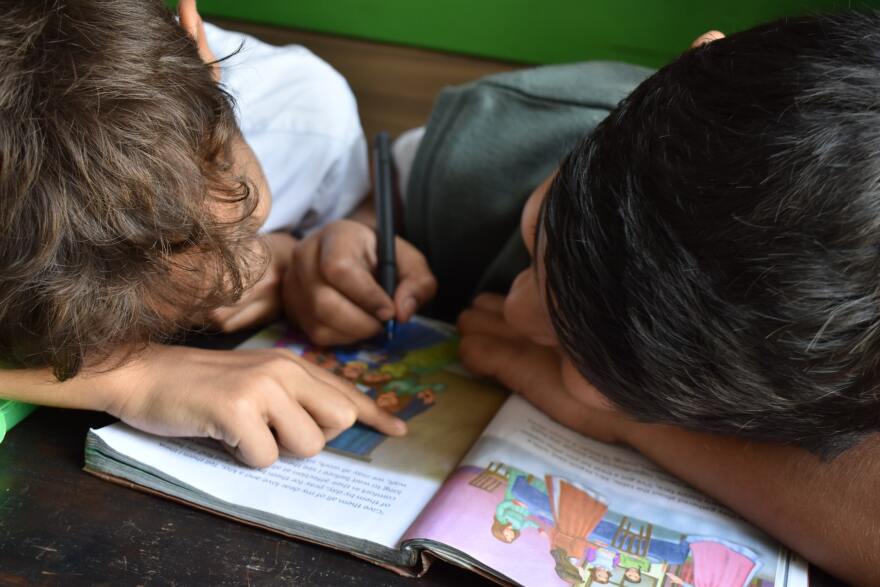There are around half a million students enrolled in Nevada public schools, and more than 14 percent of them are considered English-language learners. With schools around the country relying on distance learning to help mitigate the spread of the novel coronavirus, it’s unclear how the transition from in-person to online instruction affected those students.
To help answer that question KUNR’s Paul Boger spoke with reporter Natalie Van Hoozer to break it all down.
Paul Boger: Natalie, could you explain exactly what it means to be an “English Learner”?
Natalie Van Hoozer: When students register for school, their parents fill out a survey that asks if there’s a time when their child speaks another language other than English. If there is, the student takes an English proficiency screening test. Students who score below a certain level are considered “English Learners.” When they gain enough proficiency, they exit the English learner program and are considered bilingual.
The Washoe County School District says there are close to 9,800 English learner students in the district, making up about 16 percent of students. Janeen Kelly, the director of the English Language Development department for the district, says around 97 percent of those students are Spanish speakers, with the other 3 percent being speakers of 79 other languages. There are also students who speak English and are bilingual, though their parents don’t speak English.
Boger: We’ve heard a lot about the transition from in-person instruction to online [instruction]. What has that looked like for English learners?
Teachers say distance learning takes longer and is more complex for English learners. A school interpreter or language teacher is often involved with communicating assignments and answering questions for students.
The district delivered English packets to English learners’ homes, which were in addition to the core curriculum packets all students received for remote learning. Teachers say these English packets were pretty successful because the material was adapted to each student’s ability level.
Nancy Carroll teaches English learners at Wooster High School and said the past semester of remote learning brought some additional challenges.
“Almost a third of our EL students, I believe, are also certified [as] special education [students],” she said. “We have students who were struggling with reading, comprehension, and language and now we’re asking them basically to be responsible for their own learning.”
The English learner staff at Wooster High school pointed out that many students there also face socioeconomic challenges. Some were essential workers during this last semester, and the only member in their family working.
Boger: I’m curious, what strategies are schools and teachers using to help communicate with elementary school students and their parents who may not speak English at all?
Van Hoozer: For the lower grades, more conversation happens between school faculty and parents, since the students are too young to navigate online learning platforms and do assignments by themselves.
At schools like Echo Loder Elementary, during a typical school year, classroom assistants rotate through different lower grade classes, working with English Learner students, most of them Spanish speakers. They also interpret during parent-teacher conferences.
When the pandemic hit, these classroom assistants became liaisons between teachers and Spanish-speaking parents. At the beginning of distance learning, these interpreters each took around 50 phone calls a day. There was so much need for interpretation in Spanish that other bilingual staff, including the school’s clinical aide, were making these calls too. Once families adjusted to remote learning, the volume of calls decreased. However, with their interpretation work, these assistants are still key in communicating the different personal situations of each family to the school.
These classroom assistant positions are 35 hours per week, funded by a state grant called Zoom (which is not to be confused with the video conferencing platform). With uncertainty about the state’s budget for this coming fiscal year, schools don’t know if or how these positions will be funded. I reached out to the Nevada Department of Education, and they said it’s too early in the budgeting process to know what funding for this grant looks like going forward.
Boger: And how is that different for high schoolers?
Van Hoozer: Most high schoolers usually talk or message directly with their teachers, but there are high school English Learner students, some newly arrived from other countries. Paul Nolan works with this population at Hug High School. He said students did well with their English learning packets, which were adapted to their needs, but the general coursework was a challenge.
“When it comes to their core courses, like mathematics and science, that material was sent out and made with the average student in mind, not a language learner,” he said. “It’s hard for the teachers to tutor them because some of our students need an explanation in their language.”
As an example, for one French-speaking student, Hug staff worked out three-way calls between the student, her class teacher, and a French teacher who interpreted. So distance learning has been a challenge, but it’s also inspired some creativity. The question now becomes: Is it sustainable to operate and educate this way?
This story was produced in partnership with Noticiero Móvil.







